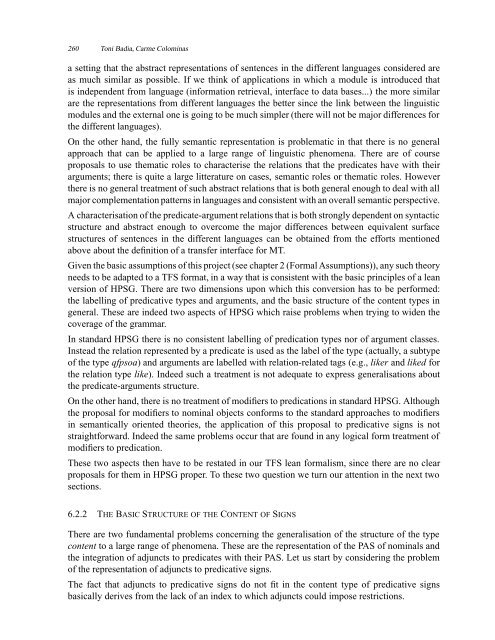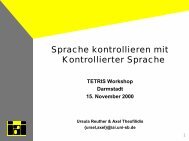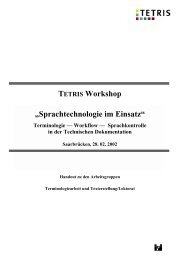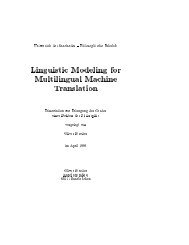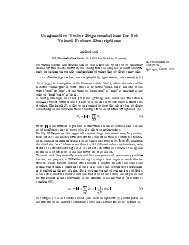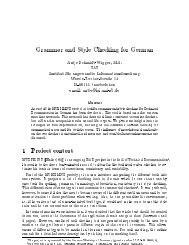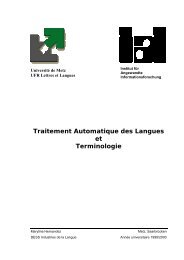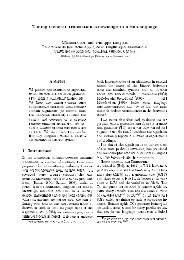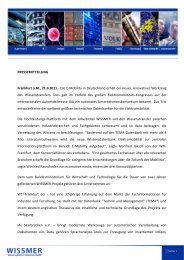Predicate-Argument Structure
Predicate-Argument Structure
Predicate-Argument Structure
Create successful ePaper yourself
Turn your PDF publications into a flip-book with our unique Google optimized e-Paper software.
260 Toni Badia, Carme Colominas<br />
a setting that the abstract representations of sentences in the different languages considered are<br />
as much similar as possible. If we think of applications in which a module is introduced that<br />
is independent from language (information retrieval, interface to data bases...) the more similar<br />
are the representations from different languages the better since the link between the linguistic<br />
modules and the external one is going to be much simpler (there will not be major differences for<br />
the different languages).<br />
On the other hand, the fully semantic representation is problematic in that there is no general<br />
approach that can be applied to a large range of linguistic phenomena. There are of course<br />
proposals to use thematic roles to characterise the relations that the predicates have with their<br />
arguments; there is quite a large litterature on cases, semantic roles or thematic roles. However<br />
there is no general treatment of such abstract relations that is both general enough to deal with all<br />
major complementation patterns in languages and consistent with an overall semantic perspective.<br />
A characterisation of the predicate-argument relations that is both strongly dependent on syntactic<br />
structure and abstract enough to overcome the major differences between equivalent surface<br />
structures of sentences in the different languages can be obtained from the efforts mentioned<br />
above about the definition of a transfer interface for MT.<br />
Given the basic assumptions of this project (see chapter 2 (Formal Assumptions)), any such theory<br />
needs to be adapted to a TFS format, in a way that is consistent with the basic principles of a lean<br />
version of HPSG. There are two dimensions upon which this conversion has to be performed:<br />
the labelling of predicative types and arguments, and the basic structure of the content types in<br />
general. These are indeed two aspects of HPSG which raise problems when trying to widen the<br />
coverage of the grammar.<br />
In standard HPSG there is no consistent labelling of predication types nor of argument classes.<br />
Instead the relation represented by a predicate is used as the label of the type (actually, a subtype<br />
of the type qfpsoa) and arguments are labelled with relation-related tags (e.g., liker and liked for<br />
the relation type like). Indeed such a treatment is not adequate to express generalisations about<br />
the predicate-arguments structure.<br />
On the other hand, there is no treatment of modifiers to predications in standard HPSG. Although<br />
the proposal for modifiers to nominal objects conforms to the standard approaches to modifiers<br />
in semantically oriented theories, the application of this proposal to predicative signs is not<br />
straightforward. Indeed the same problems occur that are found in any logical form treatment of<br />
modifiers to predication.<br />
These two aspects then have to be restated in our TFS lean formalism, since there are no clear<br />
proposals for them in HPSG proper. To these two question we turn our attention in the next two<br />
sections.<br />
6.2.2 THE BASIC STRUCTURE OF THE CONTENT OF SIGNS<br />
There are two fundamental problems concerning the generalisation of the structure of the type<br />
content to a large range of phenomena. These are the representation of the PAS of nominals and<br />
the integration of adjuncts to predicates with their PAS. Let us start by considering the problem<br />
of the representation of adjuncts to predicative signs.<br />
The fact that adjuncts to predicative signs do not fit in the content type of predicative signs<br />
basically derives from the lack of an index to which adjuncts could impose restrictions.


